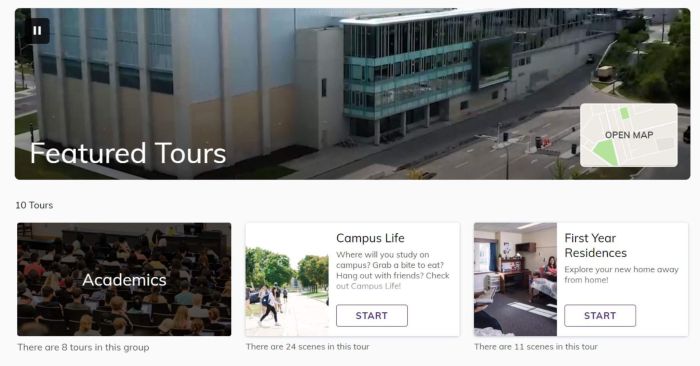As an educational institution looking to thrive and grow, increasing student enrollment is likely a top priority. Why is student enrollment important? The significance of robust enrollment numbers extends beyond filling seats as it impacts the institution’s financial health, reputation, and ability to offer diverse and dynamic programs. To stay ahead, educational institutions must continuously innovate and implement strategies that appeal to students evolving needs and preferences.
This blog aims to provide actionable insights into five key strategies to help increase your student enrollment. From enhancing online presence to leveraging data-driven marketing, these strategies are designed to help educational institutions navigate the complexities of student recruitment and achieve sustained growth. Whether you’re an administrator at a large university or a small private school, these tactics can be tailored to fit your unique context and help you attract the right students for your programs.
Struggling with enrollment?
Our Inbound Marketing team can help you generate more leads!

Strategy 1: Enhance Online Presence
Today, an institution’s online presence is often prospective students first point of contact. A well-designed, user-friendly website is the cornerstone of online presence, offering a comprehensive and engaging overview of what the institution offers. The website must be visually appealing and easy to navigate. Clear, concise information about programs, admissions, campus life, and support services should be readily accessible. Additionally, incorporating high-quality images and videos can provide an immersive glimpse into the campus experience, helping attract and retain the interest of potential students.
Search engine optimization (SEO) ensures the institution’s website ranks high in search engine results. Institutions can improve online visibility by optimizing content with relevant keywords, creating informative and engaging blog posts, and building high-quality backlinks. This increased visibility makes it easier for prospective students to find the information they need when searching for educational opportunities, thereby driving more traffic to the website.
If you want to increase your student enrollment, social media is another essential component of a strong strategy. Platforms such as Facebook, Instagram, Twitter, and LinkedIn provide valuable opportunities to connect with prospective students personally. Regularly posting engaging content, including student testimonials, campus events, and behind-the-scenes looks at campus life, can help build excitement around the institution. Additionally, social media advertising allows for targeted marketing campaigns that reach specific demographics, increasing the likelihood of attracting students who are a good fit for the institution.

Source: Facebook | NeuAge Institue
Example: Facebook reels offer an excellent opportunity for your school to increase your institution’s visibility particularly when used to impart valuable information. Here, NeuAge Institute uses its social media platform to provide current and prospective students with job interview tips – no doubt relevant to the career-seeking pharmaceutical students considering enrollment at their institution.
Beyond the website and social media, maintaining an active presence on educational forums and review sites can enhance the institution’s online visibility. Positive reviews and testimonials from current students and alumni can significantly influence the decision-making process of prospective students. Encouraging satisfied students to share their experiences online and responding promptly to inquiries and feedback can further bolster the institution’s reputation.
Finally, implementing email marketing campaigns can be a powerful strategy for those looking to learn how to increase student enrollment. Regular newsletters featuring updates about academic programs, upcoming events, and success stories can nurture leads and keep the institution top-of-mind for students. Personalized emails based on the interests and behaviors of prospective students can further enhance their effectiveness.
For expert, personalized help to increase your student enrollment, explore our digital marketing services here.
Strategy 2: Offer Competitive Financial Aid and Scholarships
One of the most effective marketing strategies to increase student enrollment is providing financial aid and scholarships, which significantly influence a student’s decision to enroll in a particular institution. Education costs are rising, and offering competitive financial aid packages can make an institution more attractive to prospective students. By highlighting these opportunities through strategic digital marketing efforts, institutions can effectively communicate their commitment to making education accessible and affordable.
Financial aid and scholarships can take various forms, including need-based aid, merit-based scholarships, grants, and work-study programs. It’s essential for institutions to clearly outline the types of aid available and the eligibility criteria for each. This information should be prominently displayed on the institution’s website, with easy-to-navigate pages dedicated to financial aid.
Leveraging social media platforms to promote financial aid opportunities can significantly enhance their visibility. Regular posts and updates about scholarship deadlines, success stories of students who have benefited from financial aid, and tips for applying can engage a broader audience. Live Q&A sessions on platforms like Facebook and Instagram can also provide prospective students with real-time information and answers to their questions, fostering a sense of transparency and support.
Email marketing is another powerful tool for reaching out to students who have shown interest in the institution. Personalized emails highlighting specific scholarship opportunities and financial aid programs tailored to the recipient’s profile can increase engagement and application rates. Additionally, automated email campaigns can be set up to remind students of upcoming deadlines and provide step-by-step guides to completing their applications.
Creating compelling content showcasing the impact of financial aid on current students can further strengthen the institution’s appeal. Testimonials from students who have successfully navigated the financial aid process and thrived can serve as powerful motivators for prospective students. These narratives provide concrete examples of how financial aid can significantly impact a student’s educational journey.
Institutions should also consider partnerships with high schools and community organizations to spread awareness about available financial aid. Hosting virtual workshops and webinars on financial literacy and scholarship application strategies can position the institution as a supportive and resourceful ally in the eyes of prospective students and their families.

Source: YouTube | AAPS
Example: Here, AAPS demonstrates its dedication to making its programs more accessible to prospective students. Financial Aid can be challenging to navigate with each institution’s distinct application process. This YouTube video assures students that the process is simple, and completed in 5 steps.
Strategy 3: Leverage Alumni Networks
Alumni networks are a powerful yet often underutilized resource for increasing student enrollment. Alumni can serve as ambassadors, mentors, and testimonials, providing prospective students with genuine insights and success stories that resonate. By strategically leveraging alumni networks through digital marketing efforts, institutions can create a compelling narrative highlighting the long-term value of their educational programs.
One effective way to engage alumni is through social media platforms. Institutions can create dedicated alumni groups on Facebook, LinkedIn, and other social media channels where former students can share their experiences, achievements, and career advancements. Regularly featuring alumni success stories on the institution’s social media pages can provide prospective students with relatable role models and concrete examples of post-graduation success.
Email marketing campaigns tailored to alumni are vital in keeping them engaged and involved. Regular newsletters that include updates about the institution, upcoming events, and opportunities for alumni to participate in recruitment efforts can strengthen the bond between alumni and their alma mater. Personalized emails that invite alumni to share their stories or participate in virtual open houses and Q&A sessions can foster a sense of community and encourage active participation in recruitment initiatives.
Alumni testimonials are particularly effective in digital marketing campaigns. Prospective students often seek assurance that their educational investment will pay off, and hearing directly from alumni who have achieved success can provide that assurance. Video testimonials can be featured on the institution’s website, social media pages, and targeted email campaigns.
Institutions can also leverage alumni networks through mentorship programs that connect current students with alumni. Promoting these programs through digital marketing channels can attract prospective students who value networking and professional development opportunities. Showcasing the benefits of mentorship, such as career guidance, industry insights, and networking connections, can make the institution more attractive to prospective students.
Furthermore, hosting virtual events such as webinars, panel discussions, and career fairs featuring alumni speakers can draw in prospective students. Promoting these events through social media, email campaigns, and the institution’s website can increase visibility and participation. Alumni can share their experiences, offer advice, and answer questions from prospective students, providing an authentic and engaging perspective on the institution’s impact.

Source: JCU
Example: Here, John Cabot University leverages its alumni network, showcasing a compelling testimonial from a member of their Alumni Association. A strong Alumni network shows prospective students that your institution’s support goes beyond graduation. Satisfied alumni also serve as an invaluable source of social proof.
Strategy 4: Utilize Data-Driven Marketing
Utilizing data-driven marketing strategies has become one of the most essential ways to increase student enrollment. Data-driven marketing involves using data analytics to inform and optimize marketing efforts, ensuring they are effective and efficient. By leveraging data, educational institutions can gain valuable insights into prospective students’ preferences, behaviors, and decision-making processes, allowing for highly targeted and personalized marketing campaigns.
The first step in data-driven marketing is to collect and analyze data from various sources. This can include website analytics, social media metrics, email marketing performance, and information gathered through online forms and surveys. Tools like Google Analytics, social media insights, and customer relationship management (CRM) systems can provide comprehensive data sets that reveal trends and patterns in prospective student engagement. By understanding which pages on the institution’s website are most visited, and which social media posts generate the most interaction institutions can tailor their content and strategies to meet their audience needs.
Segmentation is a crucial component of data-driven marketing. Institutions can create more personalized and relevant marketing messages by dividing the prospective student pool into segments based on demographics, interests, and behaviors. For example, prospective students interested in science and technology programs may respond better to content highlighting research opportunities and cutting-edge facilities. Personalized marketing campaigns can include targeted email sequences, tailored social media ads, and customized website experiences that resonate with each segment.
Predictive analytics is another powerful tool in data-driven marketing. By analyzing historical data, institutions can predict future behaviors and trends, allowing them to proactively address challenges and opportunities. For instance, if data indicates a drop in engagement from a particular demographic, targeted campaigns can be developed to re-engage that group.
Marketing automation and CRM platforms such as Mautic can further enhance data-driven marketing efforts by streamlining and optimizing communication with prospective students. Automated email campaigns can be triggered based on specific actions, such as downloading a brochure or attending a virtual open house. These automated sequences can nurture leads through the enrollment funnel, providing timely and relevant information that guides prospective students toward making an informed decision.
Social media advertising is another area where data-driven marketing can have an impact. Platforms like Facebook, Instagram, and LinkedIn offer advanced targeting options that allow institutions to reach specific audiences based on various criteria, including location, age, interests, and behavior. By leveraging these targeting capabilities, institutions can ensure that their ads are seen by the most relevant audiences, increasing the likelihood of engagement and conversion.
Finally, continuous monitoring and optimization are key to the success of data-driven marketing. By regularly reviewing performance metrics and making data-informed adjustments, institutions can refine their strategies to achieve better results. A/B testing different versions of marketing materials, analyzing the outcomes, and implementing the most effective variations can significantly improve engagement and enrollment rates. Here’s a visual representation of the process of data-driven digital marketing:

Source: HEM
Strategy 5: Enhance Student Experience
A positive and enriching student experience is a powerful tool for increasing student enrollment. When current students are satisfied and thriving, they become ambassadors for the institution, sharing their experiences and attracting new students. Enhancing the student experience involves a holistic approach encompassing academic support, extracurricular activities, campus facilities, and overall well-being. By effectively communicating these aspects through digital marketing strategies, institutions can highlight their commitment to student success and create a compelling narrative for prospective students.
One of the key elements of enhancing student experience is providing robust academic support. This includes accessible and personalized advising, tutoring services, and career counseling. Digital marketing efforts should showcase these resources, emphasizing how they help students achieve their academic and professional goals.

Example: ACA regularly features success stories from their students that highlight how they provide support on an academic and personal level.
Extracurricular activities and student organizations are vital in creating a vibrant and engaging campus life. Highlighting these opportunities through digital marketing can attract students who value a well-rounded college experience. Institutions can create engaging content that showcases various clubs, sports teams, special interest groups, and events such as student fairs, competitions, and cultural festivals. Social media platforms are particularly effective for sharing real-time updates and behind-the-scenes glimpses of these activities, fostering community and excitement.
Campus facilities also significantly impact the student experience. Modern, well-maintained facilities, including state-of-the-art classrooms, laboratories, libraries, and recreational centers enhance learning. Virtual tours and high-quality videos showcasing these facilities can be featured on the institution’s website and social media pages, allowing prospective students to visualize themselves on campus. Testimonials from students and faculty highlighting the benefits of these facilities can further enhance their appeal.

Source: University of Western Ontario
Example: How do you encourage enrollment? By enhancing the student experience at every stage of the enrollment funnel. Here, the University of Western Ontario provides a convenient but engaging experience through various remote campus tours. Your digital marketing efforts should reflect a robust student life relating to extracurricular activities, career development opportunities, and your school’s commitment to student well-being.
Student well-being is another critical component of the student experience. Institutions should emphasize their commitment to mental health and wellness through comprehensive support services, such as counseling, health services, and wellness programs. Digital marketing strategies can include blogs, videos, and social media posts that discuss these services and provide tips for maintaining a healthy and balanced lifestyle. Highlighting initiatives such as stress-relief events, fitness classes, and wellness workshops can demonstrate the institution’s proactive approach to student well-being.
Student testimonials and success stories are powerful tools for enhancing the institution’s image. Featuring these stories in various digital formats, such as videos, blogs, and social media posts, can provide prospective students with relatable and inspiring examples of what they can achieve. Institutions should encourage current students and alumni to share their experiences and achievements.
Engaging with prospective students through personalized communication can also enhance their perception of the institution. Responding promptly to inquiries, providing detailed information, and offering virtual meetings or campus tours can make prospective students feel valued and supported. Automated email campaigns that deliver relevant content based on prospective students’ interests and behaviors can nurture leads and keep them engaged throughout the decision-making process.
How To Increase Your Student Enrollment: Final Thoughts
By implementing the five strategies outlined in this blog, institutions can create a robust framework for increasing student enrollment. Each of these strategies, when executed effectively, contributes to a cohesive and compelling narrative that resonates with prospective students and their families. Institutions must continuously evaluate and adapt their approaches, staying attuned to students evolving needs and preferences. By fostering a dynamic and supportive environment, educational institutions attract new students and build a loyal and engaged community that supports long-term success.
Ultimately, the key to increasing student enrollment is demonstrating a genuine commitment to student success and well-being. By highlighting the unique strengths and opportunities offered, institutions can create a compelling case for why prospective students should choose their programs. As educational landscapes evolve, institutions that prioritize innovation, engagement, and student-centered strategies will stand out and thrive.
Struggling with enrollment?
Our Inbound Marketing team can help you generate more leads!

Frequently Asked Questions
Question: Why is student enrollment important?
Answer: The significance of robust enrollment numbers extends beyond filling seats as it impacts the institution’s financial health, reputation, and ability to offer diverse and dynamic programs.
Question: How do you encourage enrollment?
Answer: By enhancing the student experience at every stage of the enrollment funnel.






